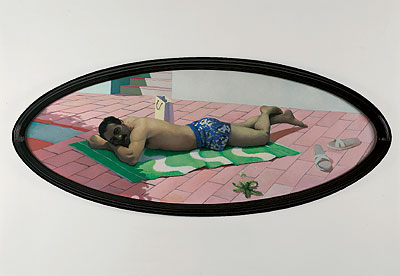| Umělec magazine 2004/2 >> To Turn Away. To Plead | List of all editions. | ||||||||||||
|
|||||||||||||
To Turn Away. To PleadUmělec magazine 2004/201.02.2004 Wolf Günter Thiel | en cs |
|||||||||||||
|
Lukas Duwenhögger is a painter in the classical sense of the word, who also meets our expectations of a conceptual artist. He is most concerned with the role of the artist, whose very person is presented as an aspect of artistic culture. Duwenhögger is an artist who draws conclusions from the public reception of his work both through his painting and in his personal life. That is why he moved from Berlin to Istanbul.
The Taxonomy of Art and the Challenge of the Market Lukas Duwenhögger also opposes the usual artistic taxonomies applied to working methods. He paints a limited number of pictures every year, and he enjoys the fact that his work is receiving considerable respect in the art world. He is in control of his own market, for which he creates artworks purposefully, managing them all the way up to the point of sale, at a significant market value. To him, it is important that painting – particularly oil painting – be endowed with greater value stability and content complexity, and be delivered to the market where values are traditionally established. He tries to define himself in opposition to internationally promoted attitudes by the likes of Elizabeth Peyton or John Currin. Homosexuality and Social Obligations He has in common with these artists a shared conceptual interpretation of painting. His conceptual platform is in opposition towards the painting of modernism and the all-embracing content of contemporary painting. To reach that point, he emphasizes intimacy and presents himself as a gay painter. This intimacy is logical only if we approach his iconography from a detached perspective. It’s not about brushwork or subjective expression in various circumstances, but a more generally experienced confrontation with expected social attitudes and requirements. In this sense, it is a very honest approach, with a lot of resolution to come out, set his head on a parapet and, figuratively speaking, expose himself. Unlike Neo Rauch, he is uninterested in developing his own style that will sell itself one day. In spite of this, it’s clear that he has created a very personal language in which the iconography of pictorial production is is clear, and thus understood monolithically. The Luxury of Isolation It’s not about the brush or the style but authenticity. Lukas Duwenhögger puts himself at stake and presents himself to the public as a homosexual painter, offering as such a key to understanding his work. Within the homosexual community, there is a variety of strategies of handle ones orientation. Some want it to be ignored; others, including Duwenhögger, urge this disposition to be clearly made visible as a quality that has a determining influence on the choice of imagery and the expression of subject. To this end, one of the most important requirements is a conscious abandonment of the rules of painting by artists like Pablo Picasso or Markus Lüpertz. His decision to reside in Istanbul is a similar diversion from the accepted rules engagement for those identified with the bohemian lifestyle, with a tendency towards peace, quiet and solitude. Many of his pictures show us situations in which people indulge in idleness or are deep in contemplation. This isolated and isolating approach considers such a luxury, that offers the open space so crucial for the present day art work of this kind. In this way, Duwenhögger resists the artistic system and recovers the moment of exclusivity, in the classical sense of the word.
01.02.2004
Recommended articles
|
|||||||||||||




.jpg.thumb.png)


.jpg.thumb.png)
.jpg.thumb.png)







Comments
There are currently no comments.Add new comment